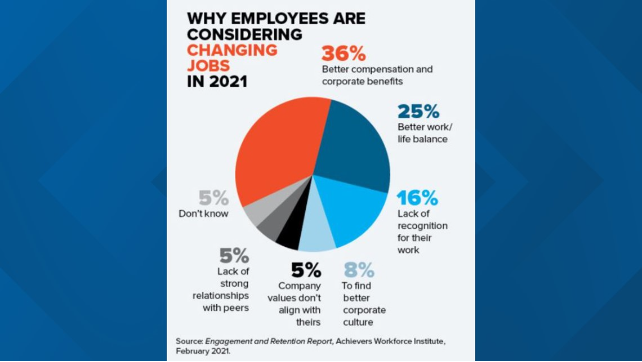- Veronika Mazour
- April 14, 2022
5 Findings about the current state of employee engagement
Even before the pandemic, employee engagement was a hot topic and a buzz word in the industry. The term was searched more than 400k times in 2018. Today, in the post-pandemic world, this number exceeds 600k, showing the continuing interest in the topic.

Content
Employee engagement seems even more key to our understanding of the job market and its trends.
So what is the state of employee engagement today, in 2022? Here are 5 quick facts and findings gathered from reputable sources that can help answer that question.
Let’s start with some figures.
1. Historic drop in employee engagement rates after a decade of rising
According to Gallup’s surveys, the percentage of engaged workers in the U.S. declined in 2021 to 34%. This compares to a previous high level of engagement of 36%. This drop, which occurred in the second half of 2021, is significant as it came after a decade of steadily increasing engagement levels throughout all industries.


FREE WHITE PAPER
Guide to
Employee Engagement
2. The “Great Resignation”
Furthermore, it appears that people are not simply disengaging, they are taking action by leaving their jobs in massive numbers.
Indeed, 4.3 million people quit their jobs in January, according to the U.S. Department of Labor’s JOLTS. The media even coined the term the “Great Resignation” in 2021, during the pandemic, in reference to the record levels of job departures. In 2021, 48 million people quit their job (an annual record), with the monthly record set in November 2021.

Part of this trend can be attributed to overall fatigue (such as in the healthcare sector) or a change in activity and/or sector (restauration sector). However, these records mostly indicate strong job markets with millions of job openings, ample job opportunities, and higher wages.
In particular, according to an analysis of BLS data conducted by the Economic Policy Institute in November 2021, hiring rates exceeded quit rates in many sectors, indicating that workers are not leaving en masse to retire in the countryside but rather are mostly switching employers in the same sector and choosing more engaging job opportunities.
In the above metrics, some notable emerging trends are worth a more attentive analysis.
3. Managers engagement rate has dropped by 7 points
Across all sectors, managing positions show the greatest decline in engagement levels—a 7% drop in 2021 according to Gallup. This goes along with a significant increase in managers burnout rates.

4. Even white collar industries are being impacted
Lower wage industries, such as food services, leisure, and hospitality, traditionally have the highest quit rates. However, the present record turnover rates are also being observed in white collar industries, such professional, business, and financial services.
These sectors, traditionally demanding on the personnel, are experiencing notable levels of employee burnout.

5. In this sea of disengagement, engagement is strong in some populations, and some companies are swimming against the current, outperforming the market
According to Gallup, some populations of younger workers (millennials) show as much as 75% engagement rates under certain conditions. The conditions include being able to work remotely, being kept in the loop and informed by managers, and being empowered with the appropriate materials and equipment to be able to perform their work right.
All of the above underline a particular kind of employee experience, which can lead to higher engagement rates than in the general market.

What conclusions can we draw from the above?
Clearly, the job market is tense and employee engagement can be key to attracting and retaining your employees, especially the young talent.
As usual, there will be some winners in this seduction game and some losers. If your organization wants to be on the winning side, you may need to urgently re-think your work paradigms with regard to remote work, management, employee tools, company communication, and other drivers of employee engagement.
with eXo Platform
FAQs
What is employee engagement?
It’s the willingness of an employee to help his company progress. It is a positive behavior, which manifests itself by a strong involvement in his work and by a great motivation. This allows the company to evolve both in terms of its activity and on a human level.
How to Improve Employee Engagement in the Workplace?
- Ensure a strong corporate culture
- Ensure good relationship with management
- Foster good relationships between the colleagues
- Think about employee recognition
- Express meaning for work in your organization
- Make well-being and work/life balance your priority
- Allow more flexibility and autonomy
- Invest in skills development and training
➝ Find out how to improve employee engagement in the workplace
- Tags: Employee engagement, Tips & Tricks
Related posts
- All
- eXo
- Digital workplace
- Open source
- Internal communication
- Collaboration
- News
- intranet
- Future of work
- workplace
- Knowledge management
- Employee engagement
- Employee experience
- Employee productivity
- onboarding
- Employee recognition
- Change management
- Cartoon
- Digital transformation
- Infographic
- Remote work
- Tips & Tricks
- Tutorial
- Uncategorized
Leave a Reply
( Your e-mail address will not be published)


